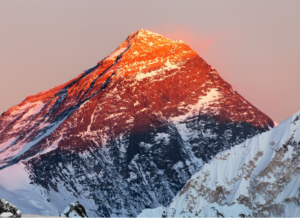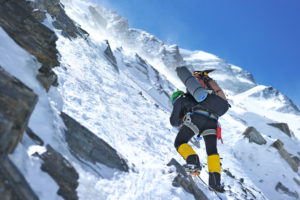Read the Following Selection
Read the following selection, or click on the play button below to listen aloud.
Mount Everest

Mount Everest is the tallest mountain in the world. At 8859 metres high, it towers over all the other mountains on Earth. Mount Everest is so huge that it even makes its own weather by changing the direction in which the wind and clouds move around it.
In Nepal, Mount Everest is called Sagarmatha, which means “Head of the Sky.” In Tibet, the mountain’s name is Chomolungma and that means Mother Goddess of the Earth. This incredible peak received the name Mount Everest in 1865. The mountain is named after Sir George Everest, a British man who was in charge of mapping the area and who was the first person to figure out exactly how tall Mount Everest is.
Climbing Mount Everest is difficult—and even deadly. One of the dangers on Mount Everest is altitude sickness, which makes climbers feel ill as they move higher. Altitude sickness is caused by the amount of oxygen in the air decreasing as people climb up the mountain. Symptoms of altitude sickness include headaches, lack of energy, joint pain, and other problems that make climbing especially tough.
Even at Base Camp, at the bottom of the mountain, where climbing groups gather and keep most of their equipment, some people really suffer from the low level of oxygen. Many climbers have made it to the top of Everest, but have not had the energy or ability to focus to make it safely back down.

There are lots of other dangers to climbers on Everest. Avalanches can sweep down the mountain almost daily. Blizzards and high winds threaten to blow climbers off the mountain.
It would be almost impossible to climb Mount Everest without the help of Sherpas, the people who live in the mountains near Everest. Because their ancestors have lived in the high altitude of the area for hundreds of years, their blood has extra red blood cells. That allows the cells to carry more oxygen than other people’s cells can carry. That is a big advantage in Mount Everest’s low-oxygen conditions.
Sherpas are excellent climbers and have incredible energy and strength. They are often hired by climbing expeditions to carry equipment and supplies. For the Sherpas, Everest is a very special and sacred place.
People had been trying to get to the top of Everest since the 1920s. On May 29, 1953, New Zealander Edmund Hillary and Sherpa Tenzing Norgay reached the summit of Mount Everest and made it back down again safely for the first time.
Mount Everest has been climbed about 6000 times but hundreds of people have died trying to make it to the top of this legendary peak. Even people who are not mountain climbers continue to be fascinated by this incredible mountain.
Now, show what you know!
Complete some questions about the reading selection by clicking “Begin Questions” below.









